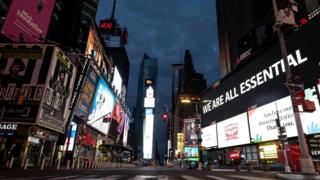 Image copyright
Getty Images
Image copyright
Getty Images
The US unemployment rate has risen to 14.7%, with 20.5 million jobs lost in April, as the coronavirus pandemic devastated the economy.
The rise means the jobless rate is now worse than at any time since the Great Depression of the 1930s.
Since the pandemic began, the US has suffered its worst growth numbers in a decade and the worst retail sales report on record.
Just two months ago, the unemployment rate was at 3.5%, a 50-year low.
Weekly figures released on Thursday showed a further 3.2 million Americans sought unemployment benefits last week. That brings the total number of jobless claims since mid-March to 33.3 million- or about 20% of the US workforce.
In recent weeks, companies such as Uber, Lyft and Airbnb were among the firms that have announced cuts, as shutdowns halted significant amounts of travel.
The impact has been felt across the economy, affecting medical practices, restaurants and administrative workers among many others. The number of new claims reported each week by the US Department of Labor has subsided since hitting a peak of 6.9 million in March.
But they remain extraordinarily high.
And the number of people collecting benefits has continued to rise, despite recent moves to start re-opening in some parts of the country.
US economy 'in medically induced coma'
Analysis by Natalie Sherman, BBC News
"It is historically unprecedented," said economist Erica Groshen, former head of the US government's Bureau of Labor Statistics, who now teaches at Cornell University. "We have put our economy into a medically induced coma in order to heal it from the pandemic... and that has led to the most precipitous loss of jobs seen in any of the modern data."
As recently as February, the US unemployment rate was hovering at historic lows, around 3.5%. But since mid-March, when officials started to impose shelter-in-place orders, employers have cut millions of people loose.
About a fifth of the workforce - more than 33 million people - had filed for unemployment in the last seven weeks.
Many are hoping that the job losses are only temporary. Some states have already started to relax restrictions, but re-starting the economy is likely to be difficult, as workers worry about the risk of infection and grapple with the impact of school closures.
"I'm not certain what's going to happen next," said Tanya Nikolaevskaya, a legal assistant in New York, who was furloughed last month, after working from home in March.
Ms Nikolaevskaya hopes to return to what she described as her dream job" but she has a medical condition and is a single mother, whose 8-year-old daughter will need care if schools do not reopen.
"It's all about, 'Is there childcare,'" she said. "If I will not have childcare, I will not be able to go back."